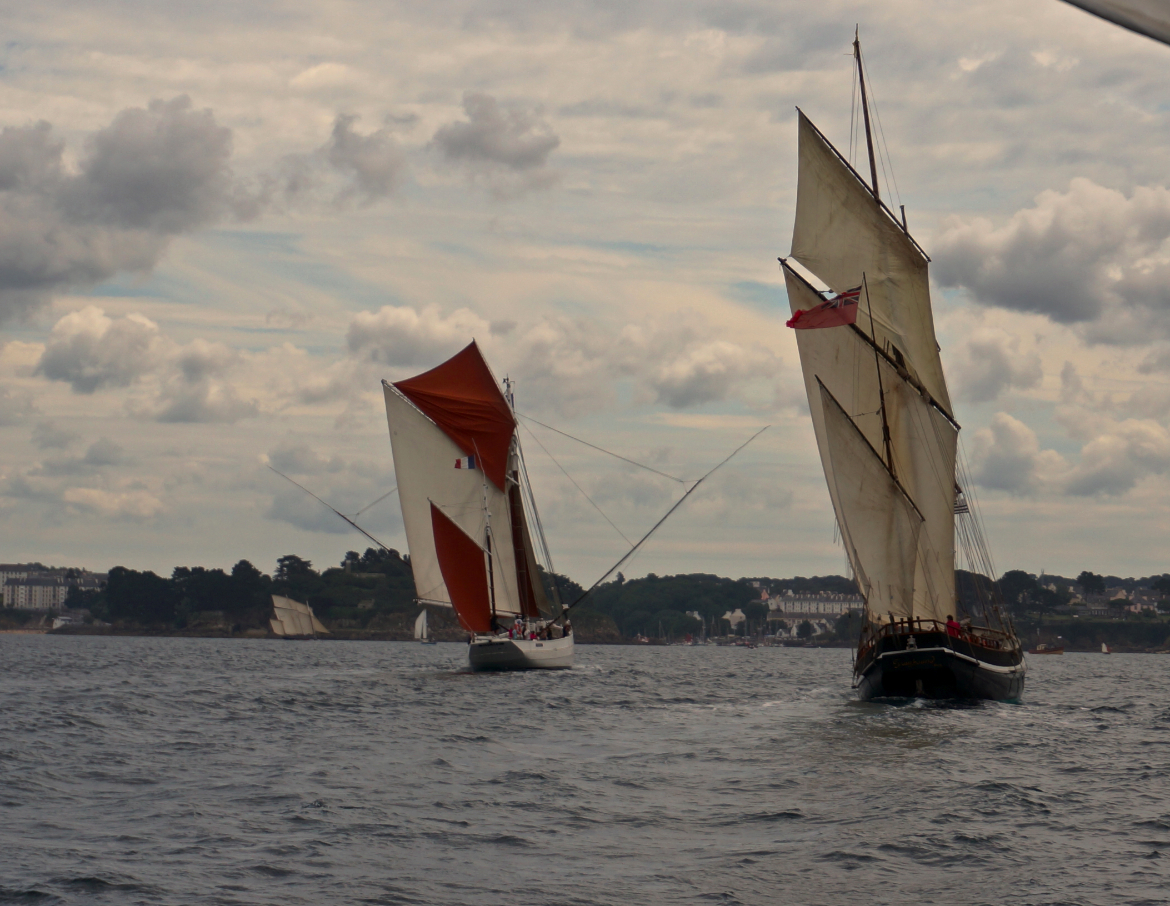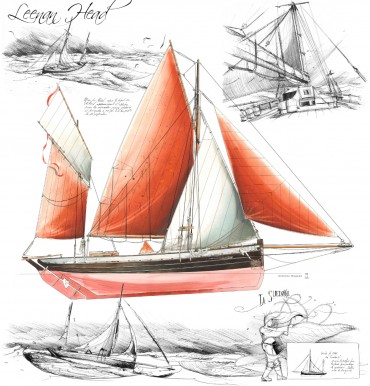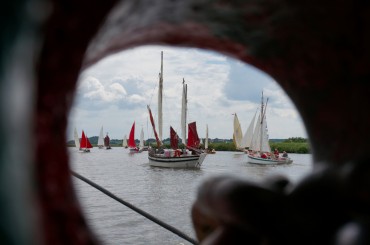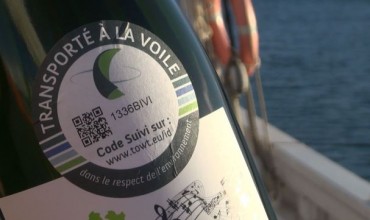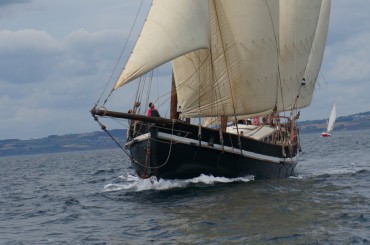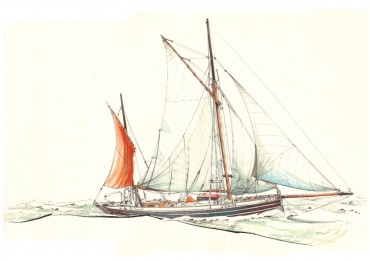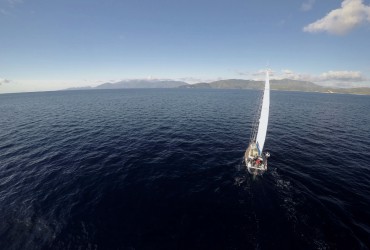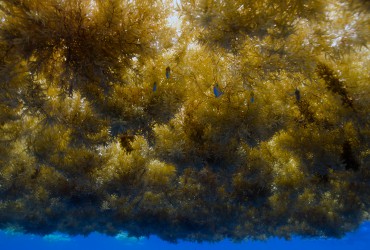The Harsh Reality
As the Notre-Dame de Rumengol slowly leaves the port of Morlaix, I keep looking at the captain who is giving orders to his crew. Their manoeuvres and skills are from another era. A marine tradition that persisted somehow through the irresistible global modernisation. In an overly technological world where millions of messages transit around the globe every second, I wonder about the raison d’être of the freight transport by sail. Is it a necessary evolution in what has become an excessive world, or just a useless step backwards?
To answer this question, we must first understand the reality behind the shiny classic sailing yacht world. Nations like France, the United Kingdom, and the Netherlands take some pride in displaying their classic sailing fleet. These vessels have become part of the national heritage. These wooden boats are now out of oblivion thanks to the passion of a handful of people willing to restore them, sometimes rebuilt them and take care of their inherent maintenance.
However, their actual purpose is mostly touristic. These ocean jewels often set sail for a single day, sometimes a week. The rest of the time, they stay in port to host upper-class cocktails and display their beauty at yacht parades. Needless to say that these events are far from the original purpose of these ships. The Notre-Dame de Rumengol, Le Biche, Tres Hombres, Grayhound, Leenan Head or Lilly Bolero (to name just a few) were all designed to restlessly roam the seas with a full hold.
Today, the world has become obsessed by fossil fuel issues and its consequences on climate change. The need for alternative energy has encouraged the idea of freight transport by sail, giving a meaningful second chance to these survivors of the maritime heritage. Moreover, to have them transporting freight across the oceans could recall a forgotten era when geography and human interactions were key elements of the world trade.
Whether it is coffee, salt, fabrics or wine, today’s goal of sail transportation is to make any product traceable from its producing area to the retail location. The trading system from sellers to customers, with importers and distributors, could be once again organized on a human scale. Who is able to say today that they know who and how is set the production and distribution systems of their new smartphone, a pair of sneakers, or even some of the common groceries? Almost no one because we don’t question attractive prices which often hides a complex and often absurd organisation.
For the past ten years in France, freight transport by sail has slowly made a come back. Commercial businesses such as “TOWT” as well as non-profit organisations such as “Un air de Fret” are making their way into the spotlight. Each of them needs to make its place in the market, thus has begun a war on communication. Simply put, a very modern reality.
Because sailing boats mainly use the power of wind, the strongest plea in their hands is the ecologically respectful aspect. “Transport by sail is definitively an alternative to oil” explains Diana Mesa, “TOWT”s co-director. At each port of call, the eco-friendly signs are proudly displayed on every delivered product, as well as on the boat. A detail that convinced several producers to work with “TOWT”. “You must be an activist to make a living out of freight transport by sail, explains to me Stephane Guichen who quarries a salt marsh next to the French island of Noirmoutier. The events such as the rise of the sea level will have a direct impact on my salt marsh, and thus on my livelihood. For the past three years, it has become more and more difficult to quarry salt here. In order to fight what seem to be unavoidable, we must change our modern way to do things, and freight transport by sail offers a real alternative.”
But is it really? A classic sailing yacht depends as much as any other on the weather conditions: erratic winds, storms, windless high pressure zones, etc. All these meteorogical situations can prevent businesses to be able to respect a timetable. The one and only solution to avoid missing a deadline remains the use of the engine.
On “TOWT”’s website, I come across the statement that their latest tour of Brittany saved a ton of CO2 from being released in the atmosphere. A statement without any further explanation.
With the figures available on Notre-Dame de Rumengol’s logbook , I find out that the sailing boat burned 750 litres of gasoline to transport 15 tons of goods on a distance of 700 nautical miles (1300 kilometres). For similar distance and weight, a common truck would have burned 300 litres of diesel*, less than half of what was necessary for the Notre-Dame de Rumengol.
In this particular case, the tag stuck on every bag claiming that it was “transported by sail, respectful of the environment” is questionable if not misleading. That said, it is worth noting that with “only” 30 tons or more of transported goods (the boat can hold up to 120 tons), the trip would have been ecologically more meaningful.
On the other hand, transport over long distances, such as the sailing yacht Tres Hombres is capable of, is another strong argument often put forward. This two-masted 32 meter long schooner is regularly chartered by “TOWT” to transport goods across the Atlantic Ocean. “There is no doubt that each voyage with Tres Hombres is ecologically more meaningful, explains Diana Mesa. As the ship doesn’t have any engine, the saved CO2 emissions is unparalleled.” What Diana Mesa doesn’t mention to say is that the Tres Hombres cannot guarantee an exact date of arrival. Some sailors reported me tales of windless days, forcing the sailing yacht to stay stuck in the same area for days, if not weeks. Nothing is predictable at sea. Certainly not nature’s whims.
Furthermore, operating a sailing boat isn’t always as “eco-friendly” as it seemed to be: “In order to have a coherent ecological case, so much more must be done, explains to me Pauline Weidmann, founder of the non-profit organization “Un air de Fret”. The sailing boat has to be considered as a whole. What about the often toxic paints used to protect the hull ? Where does the food consumed on board come from ? And what is done with the garbage and waste water?” The road to a strictly ecological transport system is still very long.
I decide to look into a more discreet aspect of freight transportation by sail: the business model and its costs. While observing the unloaded bags of salt, I ask the producer if this transport method means an increase in costs for him. “It’s simple. Compared to road transport, it triples the cost, explains Stéphane Guichen. One kilo of salt costs me 10 cents on the road, and 30 cents on the sea with Notre-Dame de Rumengol… Today I sell a kilo of salt at 1.50 euros.” As he told me earlier, one must be an activist to do this. Considering the increase of price, that’s a fact.
The results are equally mixed for organizations such as “TOWT” or “Un air de Fret”: “Our business allows two of us to live from it, explains Diana Mesa of “TOWT”. Currently, two interns and several volunteers help us… Let’s put it that way: we are not losing money. But we aren’t getting any subsidies. For the tour of Brittany we just made, the region helped us.” This is all the information I was able to get, because the topic is very sensitive.
“Un air de Fret” and similar non-profit organizations confess having problems developing their activities when competing with commercial structures: “Our project isn’t self-sufficient at the moment, regrets Pauline Weidmann. But it’s probably still a bit early. Not many people are ready to pay more. As we see it, the actual state of freight transport by sail is a way for classic yachts to find a real purpose and sail, for good. This way, the sea slowly stops being only a vast touristic playground.”
But freight transport is still a small world, and a disruptive element may jeopardize the fragile concept: excessive competition.
Last July, “TOWT”’s website announced the arrival in Brittany of an English lugger named Grayhound. It was chartered by the company to transport 500 kilos of black and green tea grown in the Azores archipelago. This product is presented as “exclusive”.
One month earlier, “Un air de Fret”’s website published an apology to their members. They explained why the chartered Lilly Bolero came back to France with no tea as it wasn’t supposed to: “A company has signed an exclusive partnership with the tea producers in the Azores… The plantation owners were approached by the company a year before we did. They must have felt the need to protect their product…”
According to our information, the mentioned company is “TOWT”. This has been confirmed by several people who currently work with them: “This topic can be seen from different angles, explains Stéphane Guichen, the salt producer. “TOWT” is trying to secure its small niche market. It’s a commercial structure, it is bound to make money in order to invest and expand… “TOWT” also asked me to sign an exclusive partnership with them for my salt. I told them that they had my word and that I considered it was enough. It’s possible that there is a war in the little world of freight transport by sail. That said, the Dutch might get everyone on the same page since they are much better than us in terms of business…”
A possibility that seems unavoidable. The United Kingdom and the Netherlands have a serious advantage on French operators : they don’t have to bother with the same rules and administration. The greatest danger for “TOWT”, “Un air de Fret” and all the other actors who wanted to be part of the adventure isn’t unfair competition, misleading communication or even financial difficulties. Today, in France, the biggest obstacle remains the law.
THE FINAL CHAPTER WILL BE PUBLISHED ON FRIDAY, THE 19TH OF SEPTEMBER 2014.
###
* A 19 ton truck uses 25 litres of diesel for every 100 km on average.
